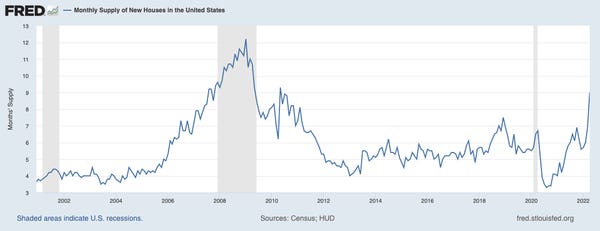[ad_1]
- Months supply of housing spiked in April as demand gets crushed by rising mortgage rates.
- Ian Shepherdson is warning home sales will decline further.
- He also warned that home prices could also see a short-term drop.
The music is beginning to stop in the housing market following one of the hottest homebuying periods in history.
As the Federal Reserve hikes interest rates to curb four-decade-high inflation, mortgage rates have soared by about 50%. That has crushed buying demand as monthly housing payments have become more expensive, sending months supply of homes soaring to the highest level in 12 years.
Federal Reserve Bank of St. Louis
According to Ian Shepherdson, the chief economist at Pantheon Macroeconomics who called the mid-2000s housing bubble, the slowdown is only going to get worse.
In recent notes to clients, Shepherdson warned that the bottom for mortgage demand is “not yet in sight.”
“It’s not rocket science; when the monthly payment for a would-be home purchaser rises by 50% in eight months, demand drops,” he said. “Expect more of the same, and it will feed into closed existing home sales in due course.”
Pantheon Macroeconomics
In addition to falling demand, Shepherdson warned that the growth of new homes being built would contribute to the the slowdown in activity.
“New home inventory now stands at 9.0 months — up from 6.9 months in March — much higher than existing home inventory, at just 2.1 months,” Shepherdson wrote in the note to clients. “Homebuilders have sought to capitalise on the shortage of existing homes by adding inventory and raising prices, which are up about 20% over the past year. But this strategy is unsustainable as demand falls sharply and inventory of existing homes rises; listings rose by 14% between February and April, with far more to come.”
He added: “In short, the party is over.”
Pantheon Macroeconomics
All of this means that home price growth is due to continue slowing down and, in the near-term, even fall, he said.
“A brief downturn is entirely possible as the market adjusts to the plunge in demand and inventory spikes higher,” Shepherdson added.
“The rate of increase of prices will slow sharply; they are massively overshooting compared to the level of inventory, even before the April jump,” he said in another note. “We can’t rule out a brief run of absolute declines as the market finds a new equilibrium.”
Pantheon Macroeconomics
But Shepherdson said the current market is not like the mid-2000s and prices will not crash in the same sustained way because there are far fewer adjustable-rate mortgages, which forced many homeowners to sell their properties the last time around. Around 40% of mortgages were adjustable in the mid-2000s compared to 1% now.
He also said a housing market slowdown wouldn’t crash the economy like it did around 2008. However, he warned that certain areas of the economy would “suffer.” These include materials, appliances, furniture.
“Homebuilders and suppliers and retailers of housing-sensitive items are going to suffer,” he said.
Fears of a housing market bubble have been brewing as mortgage rates spike. But most experts have said those fears are misguided, and home prices is unlikely to see a large decline. Many cited relatively low supply as their reason for seeing no bubble.
“The main reason we think there is no US residential housing bubble is that housing supply is very tight,” said Daan Struyven, senior global economist at Goldman Sachs, while also acknowledging that rising mortgage rates and ambiguity around pricing present challenges. “In fact, the Q1 homeowner vacancy rate fell to an all-time low of 0.8%. Similarly, the month’s supply of existing homes available for sale remained near the lowest level on record in March.”
However, supply dynamics have been quickly evolving. Months supply of homes ticked sharply higher this week, the Census Bureau and the Department of Housing and Urban Development reported (see the first chart above.) That has been fueled in part by cooling demand and spiking new home inventory.
Others, like David Rosenberg, president and chief economist at Rosenberg Research, and Desmond Lachman, senior fellow at the American Enterprise Institute, say more substantial drop is coming.
“With mortgage rates rising sharply and affordability constraints becoming so much more acute, the bursting of this bubble and the commensurate negative wealth effects promise to be spectacular,” Rosenberg said recently.
Lachman said he sees a 15-20% decline ahead.
Still, Shepherdson is not calling for a drawn-out decline in home prices, but a slowdown in appreciation and possible short-term dip as the market finds its footing amid shifting dynamics.
But shifting is the key word. As the picture evolves, and as the Fed continues on its hiking spree to slow consumer demand, market conditions could get worse for prospective sellers.
[ad_2]
Source link





